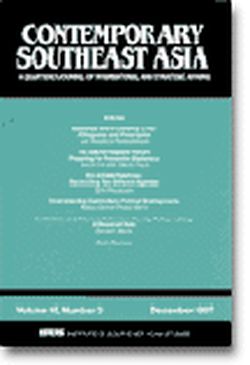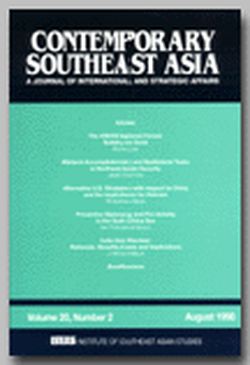Contemporary Southeast Asia: A Journal of International and Strategic Affairs Vol. 17/4 (Mar 1996)

Date of publication:
March 1996
Number of pages:
115
Code:
CS17/4
Contents
-
Preliminary pages
- ARTICLES
-
East Asian Security: Lessons from Europe?, by Kay Moller, author see abstractThis article examines the validity of an "Asian way" thesis for the management of transregional security with possible inspiration from the European experience. It explains the present inability of East Asian middle powers to restrain potential predators through institutional confidence-building and conflict prevention by the fact that emerging powers are unsatisfied players lacking the moderating influence exemplified by civil societies. Agreement on the means of enforcement would presuppose a degree of integration and co-operation achieved in Europe as the outcome of painful learning about the interaction of nationalism and economic growth between the mid-nineteenth century and 1945. For the first time in more than one hundred years, East Asia, while not yet having attained the peak of nationalism and growth, is required to provide its own answers to the same question at a fraction of the time the West had at its disposal.
-
South China Sea Fisheries: Countdown to Calamity, by Daniel Yarrow Coulter, author see abstractWith the increasing economic value of fisheries, coupled with above-average population growth rates, the riparian states bordering the South China Sea are demanding ever-increasing amounts of marine production at the expense of the maximum sustainable yield of South China Sea fishery resources. The natural replenishment cycles of fishery resources are being systematically abused, thereby threatening future marine production. Reports of poaching and illegal incidences of fishing are becoming more frequent. Demands for greater production and inadequate civil enforcement resources are two contributory factors. The navies of Southeast Asia are increasingly dedicated to"peace-time" functions such as patrolling and enforcing fishing regulations inside territorial waters. Such actions reinforce the conventional wisdom that the South China Sea remains a potential flashpoint of violence.
-
A Brief Survey of India-Indonesia Relations, by Ganganath Jha, author see abstractIn recent years, India and Indonesia have taken important initiatives to strengthen their level of co-operation and partnership. Both countries support economic liberalization and perceive scope for expansion of bilateral trade and investment. The article analyses the various factors that had created misunderstanding between the two countries in the past and emphasizes the importance of both to each other in the present. Finally, some tentative projections for future bilateral co-operation are essayed.
-
International Relations Theory and Vietnam, by Zachary Abuza, author see abstractDespite Vietnam's propaganda of following a revolutionary, international proletarian policy line, Hanoi's foreign policy has always been firmly based on Realist assumptions. With the advent of doi moi, or renovation, there has been a fundamental shift in Vietnam's world-view: Hanoi has firmly embraced the principles of complex interdependence and integration into the global economy. This transformation is most clearly seen in Hanoi's relationships with ASEAN and China. This article argues that as coping with China in traditional Realist terms is no longer tenable, and as Vietnam is too small to engage China in any degree of interdependence, Vietnam hopes to moderate Chinese behaviour through indirect complex interpendence, through membership in ASEAN, an organization Beijing deems essential to its own economic development.
-
The Political Consequences of Normalization of U.S.-Vietnam Relations, by Allan E Goodman, author see abstractThe normalization of U.S.-vietnam relations poses very difficult challenges for both Hanoi and Washington. The article argues that the leaders in both capitals will be surprised by the sensitivities involved in the negotiations ahead to establish full trade and commercial relations and that the U.S. strategy of "engagement and enlargement" may prove counter-productive. It also argues that Vietnam's embrace of free market principles is hastening the advent of civil society. The risk for American policy is that by pressing hard on the issues required for full trade relations - as opposed to granting Vietnam the same waivers that facilitate U.S. trade with China - Washington will convince the Vietnamese leadership that America is prepared to renew a struggle to liberate Vietnam.
-
Fighting the "Non-Attributable War" in Laos: A Review Article, by Nick J Freeman, author see abstractProfile of the Conflict; The Key Players; Vietnam Overtakes Laos; The Turning Point; Drawing Lessons
- BOOK REVIEWS
-
BOOK REVIEW: Business and Government in Industrialising Asia edited by Andrew MacIntyre, by Chung H Lee, author
-
BOOK REVIEW: Regional Security in the South Pacific: The Quarter Century 1970-95 by Ken Ross, by Roderic Alley, author
-
BOOK REVIEW: Co-operating for Peace by Gareth Evans, by Thomas Quiggin, author
-
BOOK REVIEW: Ideological Innovation Under Monarchy: Aspects of Legitimation Activity in Contemporary Brunei by G Braighlinn, by James Gomez, author
-
BOOK REVIEW: Historical Dictionary of Laos by Martin Stuart-Fox and Mary Kooyman, by Arthur J Dommen, author
-
BOOK REVIEW: The Chittagong Hill Tracts of Bangladesh: The Untold Story by Mizanur Rahman Shelley, by Taj ul-Islam Hashmi, author






